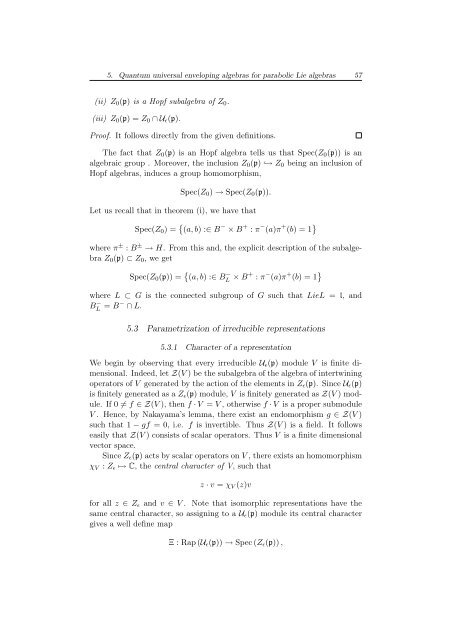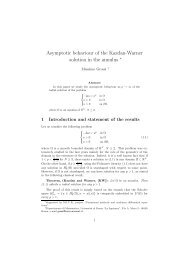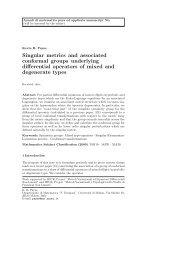Degree of Parabolic Quantum Groups - Dipartimento di Matematica ...
Degree of Parabolic Quantum Groups - Dipartimento di Matematica ...
Degree of Parabolic Quantum Groups - Dipartimento di Matematica ...
Create successful ePaper yourself
Turn your PDF publications into a flip-book with our unique Google optimized e-Paper software.
5. <strong>Quantum</strong> universal enveloping algebras for parabolic Lie algebras 57<br />
(ii) Z0(p) is a Hopf subalgebra <strong>of</strong> Z0.<br />
(iii) Z0(p) = Z0 ∩ Uǫ(p).<br />
Pro<strong>of</strong>. It follows <strong>di</strong>rectly from the given definitions.<br />
The fact that Z0(p) is an Hopf algebra tells us that Spec(Z0(p)) is an<br />
algebraic group . Moreover, the inclusion Z0(p) ֒→ Z0 being an inclusion <strong>of</strong><br />
Hopf algebras, induces a group homomorphism,<br />
Spec(Z0) → Spec(Z0(p)).<br />
Let us recall that in theorem (i), we have that<br />
Spec(Z0) = (a, b) :∈ B − × B + : π − (a)π + (b) = 1 <br />
where π ± : B ± → H. From this and, the explicit description <strong>of</strong> the subalgebra<br />
Z0(p) ⊂ Z0, we get<br />
Spec(Z0(p)) = (a, b) :∈ B −<br />
L × B+ : π − (a)π + (b) = 1 <br />
where L ⊂ G is the connected subgroup <strong>of</strong> G such that LieL = l, and<br />
B −<br />
L = B− ∩ L.<br />
5.3 Parametrization <strong>of</strong> irreducible representations<br />
5.3.1 Character <strong>of</strong> a representation<br />
We begin by observing that every irreducible Uǫ(p) module V is finite <strong>di</strong>mensional.<br />
Indeed, let Z(V ) be the subalgebra <strong>of</strong> the algebra <strong>of</strong> intertwining<br />
operators <strong>of</strong> V generated by the action <strong>of</strong> the elements in Zǫ(p). Since Uǫ(p)<br />
is finitely generated as a Zǫ(p) module, V is finitely generated as Z(V ) module.<br />
If 0 = f ∈ Z(V ), then f · V = V , otherwise f · V is a proper submodule<br />
V . Hence, by Nakayama’s lemma, there exist an endomorphism g ∈ Z(V )<br />
such that 1 − gf = 0, i.e. f is invertible. Thus Z(V ) is a field. It follows<br />
easily that Z(V ) consists <strong>of</strong> scalar operators. Thus V is a finite <strong>di</strong>mensional<br />
vector space.<br />
Since Zǫ(p) acts by scalar operators on V , there exists an homomorphism<br />
χV : Zǫ ↦→ C, the central character <strong>of</strong> V, such that<br />
z · v = χV (z)v<br />
for all z ∈ Zǫ and v ∈ V . Note that isomorphic representations have the<br />
same central character, so assigning to a Uǫ(p) module its central character<br />
gives a well define map<br />
Ξ : Rap(Uǫ(p)) → Spec (Zǫ(p)) ,








